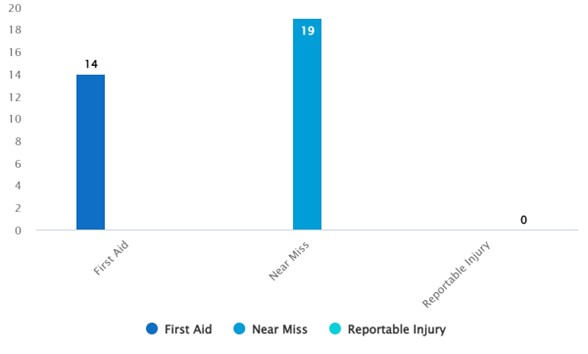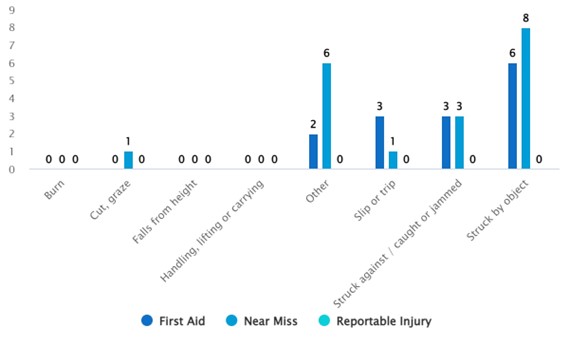Overview
During 2022/23 health and safety was managed and coordinated by our central SHE team, made up of qualified and experienced health and safety professionals. The team was supported by health and safety representatives in each business area who were trained, coached and supported to ensure they had the appropriate skills and knowledge to oversee local delivery of our policies and processes.
Health and safety performance review 2022/23
Graphic showing total accident, injury and near miss reports during 2022/23:
In the year 2022/23, there were a total of 14 reported uses of First Aid, 19 near miss incidents and 0 reportable injuries.
RIDDOR reportable incidents are certain serious work-related accidents, occupational diseases and specified dangerous occurrences which require formal reporting to the Health and Safety Executive (HSE).
A first aid treatment injury is defined as any one-time treatment and/or follow-up visit for the purposes of observation of minor injuries which do not ordinarily require medical care provided by a professional physician.
A near miss is an unplanned event that did not result in injury, illness or damage – but had the potential to do so and was only avoided by circumstance or good fortune.
Injuries and near misses by cause for 2022/23
Graphic showing injury and near miss reports during 2022/23 by cause:
|
Category |
First Aid |
Near Miss |
Reportable Injury |
|---|---|---|---|
|
Burn |
0 |
0 |
0 |
|
Cut, graze |
0 |
1 |
0 |
|
Falls from height |
0 |
0 |
0 |
|
Handling, lifting or carrying |
0 |
0 |
0 |
|
Other |
2 |
6 |
0 |
|
Slip or trip |
3 |
1 |
0 |
|
Struck against / caught or jammed |
3 |
3 |
0 |
|
Struck by object |
6 |
10 |
0 |
During 2022/23 the NHSBSA had no cases which needed to be reported to the Health and Safety Executive (HSE) under the Reporting of Injuries, Diseases and Dangerous Occurrences Regulations 2013 (RIDDOR). This is exceptional safety performance for a business of our type and size, when compared to published HSE figures. We believe that this is a result of our proactive approach to health and safety, ensuring all our people are involved, supported and understand their role in how we look after ourselves and those around us.
Prevalent injury types remained consistent, with minor cuts and grazes, general slips and trips and staff striking against objects or struck by objects. Note: The 'Other' category is used to report injury types that do not have a predefined category, for example allergic reactions and certain occupational health conditions. Across 2022/23 this number remained consistent with previous years.
The business continues to see a small number of ill health conditions reported by home workers (13 in total - 4 home workers and 9 site-based), albeit still relatively low numbers and very similar to the previous pandemic year 2021/22 (13 in total - 5 home workers and 8 site based). By comparison, in the pre-pandemic year of 2019/20, our workforce reported 65 ill health conditions whilst at work. The SHE team have worked closely with colleagues to address and support their personal needs throughout the year whilst working from home.
Key areas of activity during 2022/23
COVID-19 response
2022/23 saw us providing a 'hold and review' in relation to our COVID-19 pandemic measures.
1 April 2022 marked the ending of all legal restrictions put in place during the COVID-19 pandemic. The government’s 'Living with COVID-19' strategy was introduced, and the majority of the controls implemented across our estate remained in place throughout the year, including the provision of free lateral flow test kits for incumbent staff.
The Tactical Steering Group (TSG) that oversaw the operation of the business during the pandemic was scaled back, with fortnightly review of business impact, absence rates and the national COVID-19 status. TSG was officially stood down 1 April 2023 and the business now operates as pre-pandemic 'business as usual'.
Headcount increased across 2022/23 by around 500 staff (from about 3,800 to about 4,300) with around 90% of staff still predominantly working from home. Our NHSBSA estate has been rationalised with the closure of 3 sites (Benton, Eastbourne and Sheffield) and the reduction in floor space of one site (Wakefield), and the business is progressing with arrangements to sublet floor space in 2 of our remaining buildings (Newcastle - Stella House and Fleetwood - Hesketh House) to better utilise our remaining estate.
Across 2022/23 the SHE team continued to support the business with our hybrid way of working, whilst further rationalising our estate. The business ensured risks were assessed and appropriate arrangements put in place whilst supporting colleagues in their new way of working.
DSE / Homeworking assessment app roll out
The app, produced by NHSBSA internal IT resource and expertise, was launched in 2021/22 to cover both office and homeworking, replacing previous e-learning module and paper forms. With the majority of the NHSBSA’s workforce working remotely the app proved invaluable in assessing employee home working and workstation arrangements, as well as providing business oversight of all NHSBSA home-based assets. The app was rolled out across 2022/23 with quarterly updates on uptake reported back to the business.


